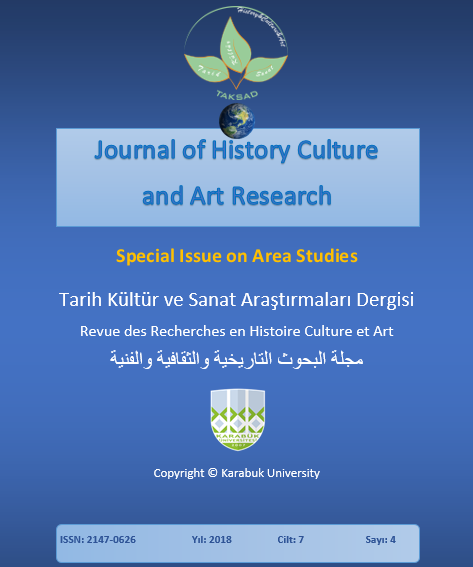Diplomatic Activities of Rome in the VIII–III Centuries BC According to Data of the Juridical Tradition
DOI:
https://doi.org/10.7596/taksad.v7i4.1800Keywords:
Ancient Rome, Roman Law Tradition, Leges regiae, The Law of the Twelve Tables, The Digest, Roman diplomacy.Abstract
This paper investigates the diplomacy of the city of Rome in Royal and Early Republican periods fragmentation. It is known that the diplomatic authorities of Ancient Rome had a legal basis, fixed in Roman law. The oldest legal norms are preserved in the quotations and paraphrases of the Roman writers, lawyers and antiquaries (Cicero, Livy, Varro, Fest and others), who lived at a later time. Based on their data it is possible to reconstruct the field of public law governing the powers of fetials and ambassadors, ius gentium in the period VII - III centuries BC. In addition, they provide an opportunity to recreate some aspects of international relations in the region (relations with the Latin League, Etruscans, Volsci, Aequi and other Italian peoples) and diplomatic activities of Ancient Rome (diplomatic rituals - the Declaration of war, conclusion of peace Treaty; the position of ambassadors, diplomatic activities of the Roman Senate and consuls).
References
Aulus Gellius (1968). “Auli Gellii Noctes Atticae”. Recognovit brevique adnotatione critica instruxit P.K. Marshall, Oxonii.
Aurelius Victor (1966). “Sexti Aurelii Victoris Liber de Caesaribus: praecedunt Origo gentis Romanae et Liber de viris illustribus urbis Romae, subsequitur Epitome de Caesaribus”. Rec. F. Pichlmayr. Lipsiae.
C. J. Smith (2014). “The Latins: historical perspective”. In. Aberson, M., Biella, M. C., di Fazio, M. & Wullschleger, M. (eds.) Entre archéologies et histoire: dialogues sur divers peuples de l’Italie préromaine: Etudes Genevoises sur l’Antiquité 2. Berne, pp. 22-30.
Digesty Iustiniana per. s latinskogo (2005). pod red. L.L. Кофанова. Мoskva.
Dionysius of Halicarnassus (1981-1986) “The Roman Antiquities”. With an English translation by E. Cary on the basis of the version of E. Spelman. Vol. I-VII. Cambridge-London.
F. Chini (2014). Idee vecchie e nuove intorno ai concetti di ius e fas, Religione e Diritto Romano. La cogenza del rito. A cura di S. Rondazzo. Trecase, pp. 115-152.
F. Fulminante (2013). The Urbanization of Rome and Latium Vetus: From the Bronze Age to the Archaic Era. Cambridge.
G. Cifani (2014). “Aspects of urbanism and political ideology in archaic Rome”. Journal of Roman Archaeology, Vol. 97, pp. 15-28.
I. L. Mayak (2013). “K voprosu o carskih zakonah v Rime”. Mnemon, Vol. 12, pp. 288-298.
J. Rüpke (2014). “Historians of religions and the space of Law”. Religione e Diritto Romano. La cogenza del rito. A cura di S. Rondazzo. Trecase, pp. 43-49.
L. L. Kofanov (2006). “Lex i ius: vozniknovenie i razvitie rimskogo prava v VIII – III vv. do n.e.”, Moskva.
M. Bartoshek (1948). “Rimskoe pravo: (ponyatiya, terminy, opredeleniya)”. Moskva.
M. David (1964). Gai institutiones secundum codicis Veronensis apographum Studemundianum et reliquias in Aegypto repertas. Leiden.
M. Johnson (2015). “The pontifical Law and civil Law. Towards an understanding of the ius pontificium”. Athenaecum, Vol. 103, pp. 140-156.
Marcus Terentius Varro (1940). “De lingua Latina”. Hrsg. Erkl. v. H. Dahlmann. Berlin.
Marcus Tullius Cicero (1883). “M. Tulli Ciceronis De legibus libri”. Rec. T. Vahleni. Berolini.
Marcus Tullius Cicero (1969). “De oratore”. Ed. K.F. Kumaniecki. Lipsiae.
Marcus Tullius Cicero (1969). “De re publica librorum sex quae manserunt”. Rec. K. Ziegler. Lipsiae.
Mark Tulliy Ciceron (1999). O gosudarstve. O zakonash. O starosti. O druzhbe. Ob obyazannostyash. Rechi. Pis’ma / per. s lat. V.O. Gorenshteyna. Moskva.
Maurus Servius Honoratus (1881). “Servii Grammatici qui feruntur in Vergilii carmina commentary”. Recensuerunt G. Thilo et H. Hagen. Leipzig.
O. Diliderto (2008). “La responsabilità nelle XII Tavole: profili palingenetici”, in a cura di L. Capogrossi Colognesi e M. F. Cursi, Forme di responsabilità in età decemvirale. Napoli, pp. 1-20.
O. Diliderto (2012). “Ut carmen necessarium (Cic. leg. 2,23,59). Apprendimento e conoscenza della legge delle XII Tavole nel I sec. a. C.”, in ricordo di E. Narducci, a cura di M. Citroni. Letteratura e civitas. Transizioni dalla Repubblica all’Impero. Pisa, pp. 141-162.
P. Sánchez (2014). “Le fragment de L. Cincius (Festus p. 276 L) et le commandement des armées du Latium”, Cahiers du Centre Gustave Glotz, Vol. 25, pp. 7-48.
P. Sánchez (2016). “Latini, id est foederat: Le statut juridique des colonies latines sous la Republique”. Athenaecum, Vol. 104, pp. 50-82.
Plutarchus (1969-1973). “Vitae parallelae”. Recogn. C.Lindskog et K. Ziegler. Vol. 1-3, Lipsiae.
S. Stassi (2014). “La presenza del sacro nel territorio albano”. In: Silvia Aglietti (ed), Res sacrae santuari e Luoghi di culto nei colli albani. Albano, pp. 7-24.
Sextus Pompeius Festus (1913). “Sexti Pompei Festi de verborum significatu quae supersunt cum Pauli epitome”. Ed. W.M. Lindsay. Lipsiae.
Titus Livius (1948). “Titi Livi Ab Urbe condita”. Rec. R.S. Conway et C.F. Walters. Tomi I-II. Oxonii.
Y. B. Tsirkin (2017). “The first Roman-Carthaginian treaty”. In: O.L. Gabelko, A.V. Korolenkov (red.), Punicheskie voyny: istoria velikogo protivostoyaniya. Voennye, diplomaticheskie, ideologicheskie aspekty bor’by mezhdu Rimom I Karfagenom [O.L. Gabelko, A.V. Korolenkov (ed.), The Punic Wars: A History of the Great Confrontation. Military, Diplomatic and Ideological Aspects of the Struggle between Rome and Carthage]. Saint-Petersburg.
Downloads
Published
How to Cite
Issue
Section
License
All papers licensed under Creative Commons 4.0 CC-BY.- Share — copy and redistribute the material in any medium or format
- Adapt — remix, transform, and build upon the material for any purpose, even commercially.
Under the following terms:
Attribution — You must give appropriate credit, provide a link to the license, and indicate if changes were made. You may do so in any reasonable manner, but not in any way that suggests the licensor endorses you or your use.
- No additional restrictions — You may not apply legal terms or technological measures that legally restrict others from doing anything the license permits.







